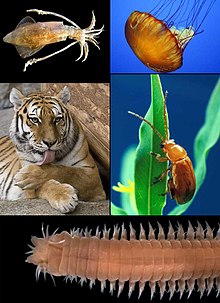
Planulozoa

| Planulozoa Temporal range:
| |
|---|---|

| |
| Diversity of planulozoans | |
| Scientific classification | |
| Kingdom: | |
| Subkingdom: | |
| (unranked): | |
| (unranked): | Planulozoa Wallberg et al., 2004
|
| Phyla | |
|
Bilateria/Triploblasts (unranked)?
| |
Planulozoa is a clade of animals that includes the superphyla Cnidaria (jellyfish, hydrozoans, sea anemones, corals, etc.) and the Bilateria (all complex animals with bilateral symmetry, including arthropods, molluscs, vertebrates, etc.).[2][3] The designation Planulozoa may be considered a synonym to ParaHoxozoa, which also contains Placozoa. Within Planulozoa, the Placozoa may be a sister of Cnidaria to the exclusion of Bilateria.[4][5][6][7] The clade excludes basal animals such as the Ctenophora (comb jellies),[8][9][3] and Porifera (sponges).[10][11][12] Although this clade was sometimes used to specify a clade of Cnidaria and Bilateria to the exclusion of Placozoa (against the original intention of its proposal), this is no longer favoured due to recent data indicating a sister group relationship between Cnidaria and Placozoa,[13] another study still supports Placozoa as sister to Cnidaria+Bilateria.[14]

The phylogenetic tree indicates approximately how many millions of years ago (mya) the lineages split. Here, Planulozoa is shown sans Placozoa.[15][16][17]

Planulozoa are associated with the emergence of the Zoc and ZF-NC gene domains.[18]


| Choanozoa |
| ||||||||||||||||||
| 950 mya |
References
- ^ Liu, Yunhuan; Carlisle, Emily; Zhang, Huaqiao; Yang, Ben; Steiner, Michael; Shao, Tiequan; Duan, Baichuan; Marone, Federica; Xiao, Shuhai; Donoghue, Philip C. J. (2022-08-17). "Saccorhytus is an early ecdysozoan and not the earliest deuterostome". Nature. 609 (7927): 541–546. Bibcode:2022Natur.609..541L. doi:10.1038/s41586-022-05107-z. ISSN 1476-4687. PMID 35978194. S2CID 251646316.
- ^ Edgecombe, G. D.; Giribet, G. (2019-01-15), "Perspectives in Animal Phylogeny and Evolution": A decade later, University of Padova Press, ISBN 9788869381409, retrieved 2019-07-17
- ^ a b Andreas Wallberg; Mikael Thollesson; James S. Farris; Ulf Jondelius (2004). "The phylogenetic position of the comb jellies (Ctenophora) and the importance of taxonomic sampling". Cladistics. 20 (6): 558–578. doi:10.1111/j.1096-0031.2004.00041.x. PMID 34892961. S2CID 86185156.
- ^ Aleshin, V. V.; Petrov, N. B. (2002). "Molecular evidence of regression in evolution of metazoa". Zh Obshch Biol. 63 (3): 195–208. PMID 12070939.
- ^ Laumer, Christopher E.; Gruber-Vodicka, Harald; Hadfield, Michael G.; Pearse, Vicki B.; Riesgo, Ana; Marioni, John C.; Giribet, Gonzalo (2018-10-30). "Support for a clade of Placozoa and Cnidaria in genes with minimal compositional bias". eLife. 7. doi:10.7554/elife.36278. ISSN 2050-084X. PMC 6277202. PMID 30373720.
- ^ Schuchert, Peter (1993-03-01). "Trichoplax adhaerens (Phylum Placozoa) has Cells that React with Antibodies Against the Neuropeptide RFamide". Acta Zoologica. 74 (2): 115–117. doi:10.1111/j.1463-6395.1993.tb01227.x.
- ^ Syed, Tareq; Schierwater, Bernd (2002-06-01). "The evolution of the placozoa: A new morphological model". Senckenbergiana Lethaea. 82 (1): 315–324. doi:10.1007/bf03043791. ISSN 0037-2110. S2CID 16870420.
- ^ Andreas Hejnol & Mark Q. Martindale (2008). "Acoel development supports a simple planula-like urbilaterian". Philosophical Transactions of the Royal Society B. 363 (1496): 1493–1501. doi:10.1098/rstb.2007.2239. PMC 2614228. PMID 18192185.
- ^ Jaume Baguñà; Pere Martinez; Jordi Paps; Marta Riutort (2008). "Back in time: a new systematic proposal for the Bilateria". Philosophical Transactions of the Royal Society B. 363 (1496): 1481–1491. doi:10.1098/rstb.2007.2238. PMC 2615819. PMID 18192186.
- ^ Whelan, Nathan V.; Kocot, Kevin M.; Moroz, Tatiana P.; Mukherjee, Krishanu; Williams, Peter; Paulay, Gustav; Moroz, Leonid L.; Halanych, Kenneth M. (2017-10-09). "Ctenophore relationships and their placement as the sister group to all other animals". Nature Ecology & Evolution. 1 (11): 1737–1746. Bibcode:2017NatEE...1.1737W. doi:10.1038/s41559-017-0331-3. ISSN 2397-334X. PMC 5664179. PMID 28993654.
- ^ C. Borchiellini; M. Manuel; E. Alivon; N. Boury-Esnault; J. Vacelet; Y. Le Parco (2001). "Sponge paraphyly and the origin of Metazoa". Journal of Evolutionary Biology. 14 (1): 171–179. doi:10.1046/j.1420-9101.2001.00244.x. PMID 29280585.
- ^ Pisani, Davide; Pett, Walker; Dohrmann, Martin; Feuda, Roberto; Rota-Stabelli, Omar; Philippe, Hervé; Lartillot, Nicolas; Wörheide, Gert (2015-12-01). "Genomic data do not support comb jellies as the sister group to all other animals". Proceedings of the National Academy of Sciences. 112 (50): 15402–15407. Bibcode:2015PNAS..11215402P. doi:10.1073/pnas.1518127112. PMC 4687580. PMID 26621703.
- ^ Giribet, Gonzalo (2020). The invertebrate tree of life. Gregory D. Edgecombe. Princeton, New Jersey. p. 46. ISBN 978-0-691-19706-7. OCLC 1129197548.
{{cite book}}: CS1 maint: location missing publisher (link) - ^ Najle, Sebastián R.; Grau-Bové, Xavier; Elek, Anamaria; Navarrete, Cristina; Cianferoni, Damiano; Chiva, Cristina; Cañas-Armenteros, Didac; Mallabiabarrena, Arrate; Kamm, Kai; Sabidó, Eduard; Gruber-Vodicka, Harald; Schierwater, Bernd; Serrano, Luis; Sebé-Pedrós, Arnau (September 19, 2023). "Stepwise emergence of the neuronal gene expression program in early animal evolution". Cell. 186 (21): 4676–4693.e29. doi:10.1016/j.cell.2023.08.027. PMC 10580291. PMID 37729907.
- ^ Peterson, Kevin J.; Cotton, James A.; Gehling, James G.; Pisani, Davide (27 April 2008). "The Ediacaran emergence of bilaterians: congruence between the genetic and the geological fossil records". Philosophical Transactions of the Royal Society of London B: Biological Sciences. 363 (1496): 1435–1443. doi:10.1098/rstb.2007.2233. PMC 2614224. PMID 18192191.
- ^ Laura Wegener Parfrey; Daniel J G Lahr; Andrew H Knoll; Laura A Katz (16 August 2011). "Estimating the timing of early eukaryotic diversification with multigene molecular clocks" (PDF). Proceedings of the National Academy of Sciences of the United States of America. 108 (33): 13624–9. Bibcode:2011PNAS..10813624P. doi:10.1073/PNAS.1110633108. ISSN 0027-8424. PMC 3158185. PMID 21810989. Wikidata Q24614721.
- ^ "Raising the Standard in Fossil Calibration". Fossil Calibration Database. Retrieved 3 March 2018.
- ^ Layden, Michael J. (2018), "Cnidarian Zic Genes", Zic family, Advances in Experimental Medicine and Biology, vol. 1046, Springer, Singapore, pp. 27–39, doi:10.1007/978-981-10-7311-3_2, ISBN 9789811073106, PMID 29442315
See what we do next...
OR
By submitting your email or phone number, you're giving mschf permission to send you email and/or recurring marketing texts. Data rates may apply. Text stop to cancel, help for help.
Success: You're subscribed now !



